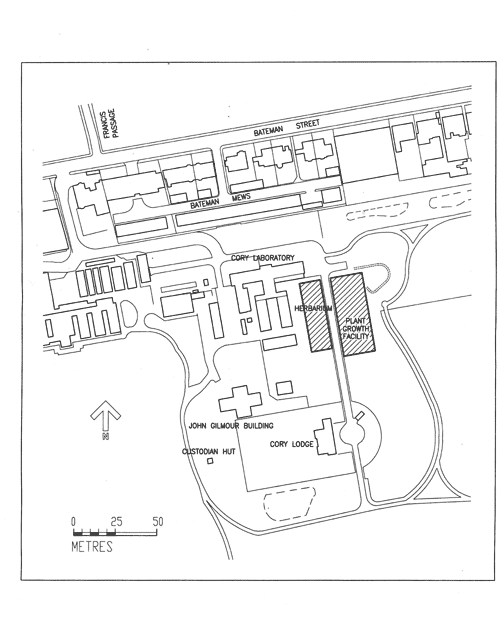|
|
|
Next page
|
The COUNCIL beg leave to report to the University as follows:
1. The Department of Plant Sciences's plant growth facilities were previously located in the Sir William Hardy Building (SWHB) on the Downing Site. These facilities were inadequate in that they offered only limited control over the growth room environments, had an inadequate number of growth rooms, and did not provide adequate containment. All these limitations affected the research that could be undertaken. Enabling works for the refurbishment of the SWHB, for the benefit of the SRIF-supported projects for the Departments of Experimental Psychology and Geography, required the plant growth facilities to be decanted to the Old Press Site. The space occupied on this site, in the basement of the building previously occupied by the Department of Applied Mathematics and Theoretical Physics (DAMTP), has only been assigned for a maximum of five years. Thus it does not provide a long-term solution for the Department's needs, especially as there has been no improvement to either the volume or quality of the accommodation provided in comparison to that in the SWHB. The recent General Board Preliminary Review of the Department recognized these problems.
2. The main Herbarium occupies part of the Plant Sciences building with a separate Moss Herbarium and a reserve collection at Laundry Farm. The 'value, significance, and research potential' of the Herbarium was reviewed by a committee appointed by the General Board in 2000. The committee's report identified the Herbarium as an irreplaceable collection with aspects that are unique and of fundamental importance, and concluded that it is a major resource for teaching and research and should be retained in Cambridge. The review also highlighted the inadequacy of the present accommodation for proper storage, curation, and exploitation of the collections and recommended that the Herbarium should be moved to purpose-built accommodation at the Botanic Garden where it could form the nucleus of a new research focus on organismal plant biology.
3. To provide the accommodation necessary to house the plant growth facilities and the Herbarium it is proposed to construct two new single-storey buildings at the Botanic Garden close to the existing Cory Laboratory. The plan dimensions of the plant growth element are approximately 48 m by 19.5 m and will provide space to house the specialist growth rooms and associated facilities (soil storage/preparation, potting/harvesting, autoclave, and wash-up, etc.), together with other miscellaneous spaces. The Herbarium is proposed to be approximately 42 m by 12.6 m and will house compactor racking for storage of the collection, a library, a preparation/drying room, a laboratory, and miscellaneous functional spaces.
4. The Department of Plant Sciences has submitted a Concept Paper, at Stage 2 of the Capital Projects Process, for the entire project and this has been approved in principle by the Planning and Resources Committee (PRC). The Concept Paper included a business plan prepared by the Department of Plant Sciences which indicated that the additional cost of running this facility would be covered by additional research overheads.
5. The plant growth element of the project is estimated to cost £6m and full funding for this has been identified, with £5m coming from the SRIF-2 allocation and £1m which the Department has received as a contribution from a charitable foundation. This Report seeks approval from the Regent House for construction of this building. No funding has yet been secured for the Herbarium and so a further Report, seeking approval for its construction, will be made in due course when full funding has been identified, hopefully from philanthropic donations.
6. Because the Botanic Garden has Grade II* registered landscape status, it will be necessary to apply for approval of the proposals from English Heritage as well as for detailed planning permission from the City Council.
7. In order to achieve a start on site in April 2004 it is necessary for design work to progress continuously from one stage to the next. It is proposed to procure the project via a 2-stage Develop and Construct route, with early engagement of a contractor to assist in the design process. The Council propose to publish a Notice giving further information about the project when the full details have been approved by the PRC.
8. The Council recommend:
I. That approval in principle be given for the construction of the plant growth building, as proposed in this Report.
II. That the Treasurer be authorized to accept the first stage tender for a 2-stage Develop and Construct contract for the plant growth building, on advice from the Director of the Estate Management and Building Service, in order that a contractor may be appointed for Stage 1 of the process.
| 9 June 2003 | ALEC N. BROERS, Vice-Chancellor | S. LEATON GRAY | JAMES MATHESON |
| R. J. ANDERSON | IAN LESLIE | MARTIN REES | |
| RICHARD BARNES | PAUL LEWIS | G. A. REID | |
| JOHN BOYD | A. M. LONSDALE | M. SCHOFIELD | |
| PETER GODDARD | D. LOWTHER | LIBA TAUB | |
| D. A. GOOD | D. W. MACDONALD | JOAN M. WHITEHEAD |

|
|
|
Next page
|
Cambridge University Reporter, 11 June 2003
Copyright © 2003 The Chancellor, Masters and Scholars
of the University of Cambridge.